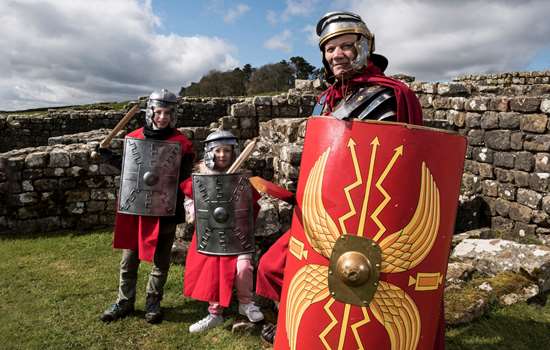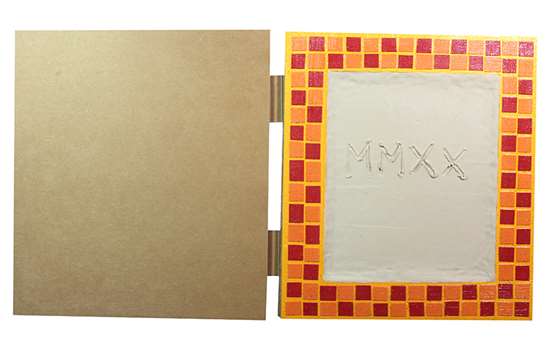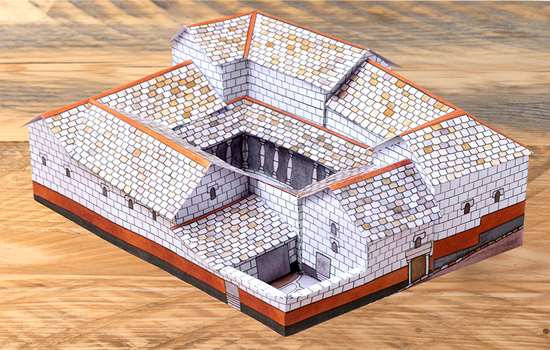Food
With the Romans came new foods from the Mediterranean, however, imported items were expensive and only available to wealthy people who could afford them. These included olive oil and wine; fruits such as figs, dates, grapes and peaches; nuts, like walnuts and almonds; and seeds. They brought over popular herbs and spices used in cooking too, including garlic, pepper, basil, thyme and coriander.
More meat was consumed under Roman rule, compared with before. The average size of cows increased, pigs were kept by many people and the owners of some Roman villas became rich by farming sheep. The Romans also introduced more animals which were eaten, including rabbits, pheasants and brown hares, which still live wild in the countryside today.
Find out more about what the Romans ate and have a go at making a Roman recipe at home by clicking the link below.
Tuck into some Roman foodRoads
After the Roman invasion in AD 43, a new network of roads was quickly built to link important military places together, as well as settlements that already existed (like Colchester in Essex and Silchester in Hampshire). Boats, both on the sea and on rivers, were also very important ways that the Romans travelled to and moved around this new province of the empire.
New roads allowed troops, messengers and goods from the rest of the Roman Empire to travel easily from ports on the coast, like Richborough and Dover in Kent. As Roman power extended across Britain, so did the roads. Eventually, they linked the south coast ports to Hadrian’s Wall in the north and even reached into areas in Scotland today.
However, away from the main roads built by the Roman army, most people continued to use the ancient tracks between fields and farms that had existed for a long time before the invasion. Many goods and supplies moving from the countryside into towns travelled along these tracks before reaching the main roads.
Play Race to Chesters!Towns
Travellers on the new roads would have seen villages and towns growing up beside them, with Roman-style rectangular houses and shops along the main street. Urban living in large towns was a big change and every family visited one, even if it was just to pay their taxes.
There were 22 major towns in Britain. Some of these were capitals based on the Iron Age tribes who lived in each area of Britain before the Roman invasion, and some were originally settlements for legionary veterans, which grew big over time. Large towns had markets, where goods and produce from the countryside and across the empire could be sold; people could hear proclamations being read out; and they could follow what was happening at the town council.
There were smaller settlements too, where iron, pottery and glass goods might be manufactured and farming products and produce could also be bought or traded. These are also often found near to large villas.
Roman Villas
The people of Iron Age Britain lived in roundhouses. These were gradually mixed with (or replaced by) Mediterranean style farmhouses, or villas. Some of these were owned by British people who became rich under Roman rule; some were given to army veterans; and some were owned by the emperor, and were run on his behalf.
A villa was more than just a comfortable house – it was also the focus of a small farming community that might include an extended family, their servants, estate workers, and slaves too. Some villas were very grand, with private baths, decorative painted plaster on the walls and expensive mosaics. Villas could have one or two floors, and some were painted on the outside as well as inside. They also had farm buildings and homes for workers.
The owners of villas were able to live in such luxury thanks to the money they could make from the farmland around them. They wanted an ideal Roman style life of leisure in the countryside, and so many villas were built with beautiful views of the landscape. Some villas even had formal planted gardens, though there isn’t much evidence of these that survives today.
Make a Roman mosaicKeeping clean
Bathing wasn’t just a way for the Romans to keep clean, it was also an important social time, where friends might meet and chat, people could practice exercise and business deals could be made.
Watch this animated video to see what bathing was like in a Roman town like Wroxeter, or ‘Viroconium’, as the Romans called it.
Medicine and doctors
Many of the new plants the Romans brought with them weren’t just edible – they were used as medicines too. People who became ill in Roman Britain could visit a doctor, if they could afford to pay for one. The Roman army had its own doctors, and some of the forts on Hadrian’s Wall even had hospitals. Medical and surgical instruments are often found in excavations of Roman towns and military sites like forts.
People who didn’t have enough money to pay a doctor used herbal remedies made at home from plants, as well as religious beliefs, wearing amulets for protection and magic spells to try to prevent and cure disease. Those who bathed at public baths might have been cleaner and fresher, but the waters of the baths could have helped spread eye diseases. Blocks of eye ointments were a very popular treatment that people could buy.
Religion
Roman gods, such as Jupiter, Juno and Minerva – and even the Roman emperor! – were honoured and worshipped at temples in Britain. The Romans and most people in Iron Age Britain believed that there were local gods or spirits in every place. It made sense to honour them, so the Romans tried to match their gods with those of local people. Because of this, worship of local gods and Iron Age beliefs continued alongside new ones.
The Romans also introduced gods from other places in the empire, including Mithras, a Persian god of light and rebirth who was worshiped by soldiers at forts on Hadrian’s Wall. Watch the video to learn more about Mithras.
The arrival of another religion changed all of this. We don’t know exactly when Christianity was brought to Britain, but it became more and more popular with wealthy people in the 4th century AD. Religion and everyday life were not separated in Roman Britain, and all Roman houses had shrines in them for the family’s worship. After Christianity was introduced, many villas had Christian images, and at Lullingstone Roman Villa in Kent, a house-church was decorated with Christian wall paintings.
Learn more about the Romans
Now you've found out how life changed after the Romans arrived, step into more fun in the past and explore our Kids Rule! guide to the Romans. Find out about the Roman Conquest and Hadrian's Wall, meet a legionary and get hands-on in the kitchen to make your own Roman burgers!
Plus: videos to watch, crafty how-to guides, quizzes to test your knowledge and read Kids Rule! magazines online.
Explore Roman Britannia



